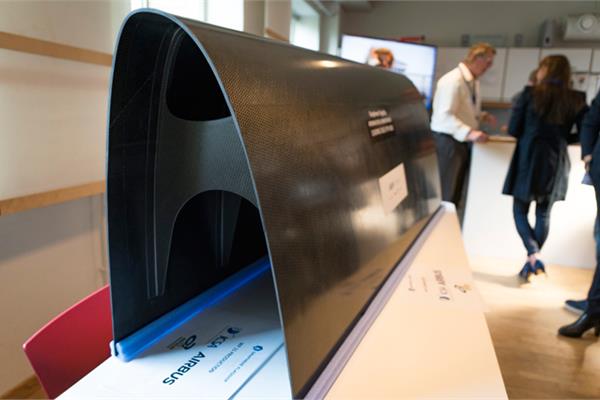
Graphene Flagship partners Aernnova, Grupo Antolin-Ingenieria and Airbus produced a leading edge for an Airbus A350 horizontal tail plane using graphene.
The leading edge is the part of the airplane wing or tail plane that first contacts the air. It must possess excellent mechanical and thermal properties. Graphene increases the mechanical properties of the leading edge, enabling to make it thinner, decreasing its weight, while maintaining its functions. This results in significant fuel saving, with consequent costs and emissions reduction over an aircraft lifetime.
The Graphene Flagship has an increasing number of industrial partners, working together to achieve the common goal to develop new technologies based on graphene and related materials. A clear example of the benefit of such collaborative approach is the work done by Flagship partners Aernnova, Grupo Antolin-Ingenieria and Airbus to produce the first leading edge of an Airbus A350 horizontal tail plane using graphene.
"We worked together with Grupo Antolin-Ingenieria and Airbus as part of the Graphene Flagship's Production Work Package and our collaboration greatly benefitted from the discussions during the Work Package meetings," said Ana Reguero from Aernnova. "It was Airbus that brought us (as the manufacturer of the current leading edge) together with Grupo Antolin-Ingenieria on the leading-edge project."
As the first part of the tail plane to contact air, the leading edge is subjected to extreme temperatures caused by compressive heating of the air ahead of the wing. Thus, it must possess excellent mechanical and thermal properties.
"Aernnova supplied the resin to Grupo Antolin-Ingenieria who added graphene directly to the resin and applying milling forces. This creates small graphene particles, an important step to get good graphene infiltration within the resin, avoiding unwanted impurities, such as solvents, which can alter the viscosity of the resin. It is important to maintain the correct viscosity of the resin to ensure the optimal outcome during the resin transfer moulding of the leading edge," said Reguero.
At a component level the team found that the resin showed increased mechanical and thermal properties upon graphene addition, including a decreased fracture speed. By increasing the resin properties with graphene, it will be possible to make the tail edge thinner, decreasing its weight while maintaining its safety. This will give a significant saving in fuel and therefore costs and emissions over the aircraft lifetime.
"Our small-scale tests showed an increase in properties. By end 2018 we will test a one third scale model," said Reguero.
"This work demonstrates the huge potential of graphene to improve the resin matrices employed in the aerospace sector. It establishes value chains in which graphene producers, resin and composite manufacturers, as well as end users, collaborate closely together to develop new composite products of improved properties" said Costas Galiotis, Composites Work Package Leader from FORTH, Greece.
Professor Andrea C. Ferrari, Science and Technology Officer of the Graphene Flagship, and Chair of its Management Panel added, "This is a great example of the collaborations fostered by the Graphene Flagship. Three of our industrial partners came together to address a key problem and found that graphene offers a solution beyond the state of the art. The development and system integration of graphene-based technologies follows the plans of our innovation and technology, where composite technologies play a prominent role."
About Graphene Flagship
The Graphene Flagship is a Future and Emerging Technology Flagship by the European Commission.
With a budget of €1 billion, the Graphene Flagship represents a new form of joint, coordinated research on an unprecedented scale, forming Europe's biggest ever research initiative.
The Graphene Flagship is tasked with bringing together academic and industrial researchers to take graphene from the realm of academic laboratories into European society in the space of 10 years, thus generating economic growth, new jobs and new opportunities.
The core consortium consists of over 150 academic and industrial research groups in 23 countries. In addition, the project has a growing number of associated members that will be incorporated in the scientific and technological work packages from the Horizon 2020 phase (1 April 2016 – 31 March 2018).